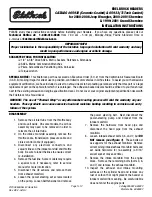
Load Capacity Labeling
It is important to understand how much
weight your Model S can safely carry. This
weight is called the vehicle capacity weight
and includes the weight of all occupants,
cargo and any additional equipment added to
your Model S since it was manufactured.
Two labels attached to the center door pillar
indicate how much weight Model S can safely
carry. Labels are visible when the front door is
open.
1. Tire and Loading Information Label
2. Statutory Plate
WARNING:
Overloading Model S has
an adverse effect on braking and
handling, which can compromise your
safety or cause damage.
CAUTION:
Never load more than 300
lbs (136 kg) in the front trunk. Doing
so can cause damage.
CAUTION:
Never load more than 175
lbs (80 kg) on the rear load floor
(above the lower trunk compartment)
or more than 285 lbs (130 kg) in the
lower trunk compartment. Doing so
can cause damage.
CAUTION:
Never store large amounts
of liquid in Model S. A significant spill
can cause electrical components to
malfunction.
Tire and Loading Information
Label
The Tire and Loading Information label
provides:
• The maximum number of occupant
seating positions.
• The maximum vehicle capacity weight.
• The size of the original tires.
• The cold inflation pressures for the
original front and rear tires. These
pressures are recommended to optimize
ride and handling characteristics.
Never change this label, even if you use
different tires in the future.
NOTE:
If Model S is loaded to its full capacity,
double check all tires to ensure they are
inflated to their recommended pressure
levels.
Statutory Plate
In addition to the VIN, the Statutory Plate
provides:
• GVWR - Gross Vehicle Weight Rating. The
maximum allowable total mass of
Model S. This is calculated as the weight
of Model S, all passengers, fluids, and
cargo.
• GAWR - Gross Axle Weight Rating for the
front and rear axles. The GAWR is the
maximum distributed weight that each
axle can support.
Vehicle Loading
198
MODEL S OWNER'S MANUAL
















































